engine overheat CHEVROLET EXPRESS 2020 Get To Know Guide
[x] Cancel search | Manufacturer: CHEVROLET, Model Year: 2020, Model line: EXPRESS, Model: CHEVROLET EXPRESS 2020Pages: 356, PDF Size: 5.7 MB
Page 226 of 356
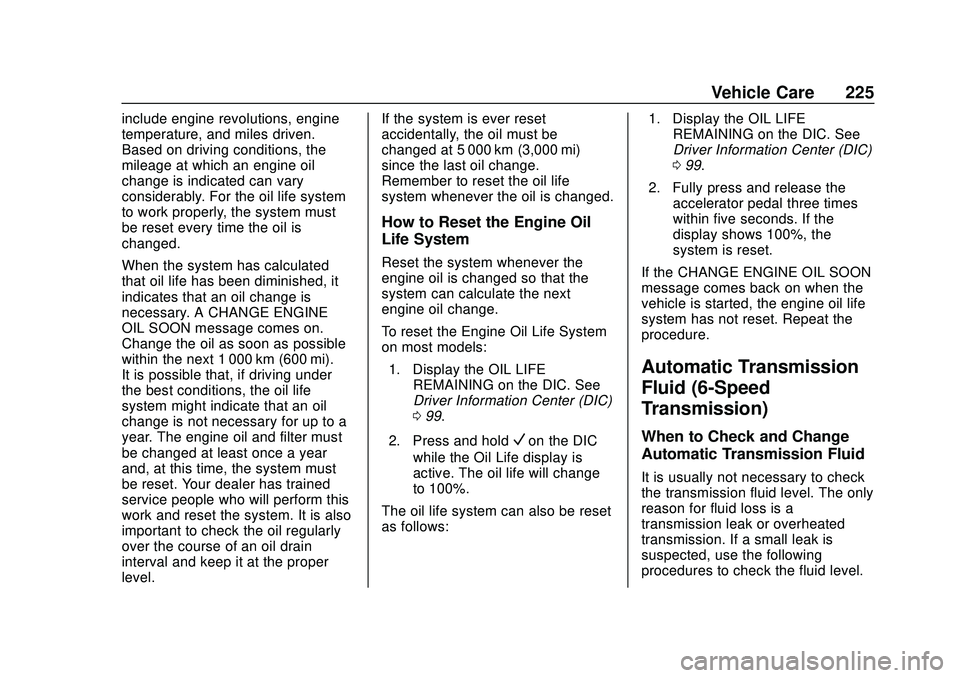
Chevrolet Express Owner Manual (GMNA-Localizing-U.S./Canada/Mexico-
13882570) - 2020 - CRC - 11/1/19
Vehicle Care 225
include engine revolutions, engine
temperature, and miles driven.
Based on driving conditions, the
mileage at which an engine oil
change is indicated can vary
considerably. For the oil life system
to work properly, the system must
be reset every time the oil is
changed.
When the system has calculated
that oil life has been diminished, it
indicates that an oil change is
necessary. A CHANGE ENGINE
OIL SOON message comes on.
Change the oil as soon as possible
within the next 1 000 km (600 mi).
It is possible that, if driving under
the best conditions, the oil life
system might indicate that an oil
change is not necessary for up to a
year. The engine oil and filter must
be changed at least once a year
and, at this time, the system must
be reset. Your dealer has trained
service people who will perform this
work and reset the system. It is also
important to check the oil regularly
over the course of an oil drain
interval and keep it at the proper
level.If the system is ever reset
accidentally, the oil must be
changed at 5 000 km (3,000 mi)
since the last oil change.
Remember to reset the oil life
system whenever the oil is changed.
How to Reset the Engine Oil
Life System
Reset the system whenever the
engine oil is changed so that the
system can calculate the next
engine oil change.
To reset the Engine Oil Life System
on most models:
1. Display the OIL LIFE REMAINING on the DIC. See
Driver Information Center (DIC)
099.
2. Press and hold
Von the DIC
while the Oil Life display is
active. The oil life will change
to 100%.
The oil life system can also be reset
as follows: 1. Display the OIL LIFE
REMAINING on the DIC. See
Driver Information Center (DIC)
099.
2. Fully press and release the accelerator pedal three times
within five seconds. If the
display shows 100%, the
system is reset.
If the CHANGE ENGINE OIL SOON
message comes back on when the
vehicle is started, the engine oil life
system has not reset. Repeat the
procedure.
Automatic Transmission
Fluid (6-Speed
Transmission)
When to Check and Change
Automatic Transmission Fluid
It is usually not necessary to check
the transmission fluid level. The only
reason for fluid loss is a
transmission leak or overheated
transmission. If a small leak is
suspected, use the following
procedures to check the fluid level.
Page 227 of 356
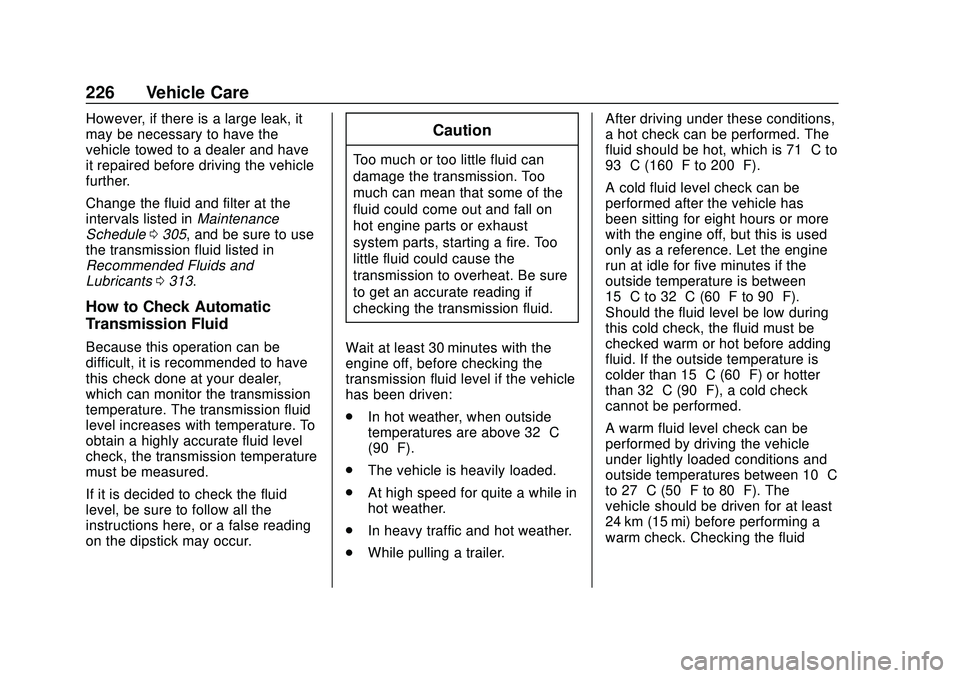
Chevrolet Express Owner Manual (GMNA-Localizing-U.S./Canada/Mexico-
13882570) - 2020 - CRC - 11/1/19
226 Vehicle Care
However, if there is a large leak, it
may be necessary to have the
vehicle towed to a dealer and have
it repaired before driving the vehicle
further.
Change the fluid and filter at the
intervals listed inMaintenance
Schedule 0305, and be sure to use
the transmission fluid listed in
Recommended Fluids and
Lubricants 0313.
How to Check Automatic
Transmission Fluid
Because this operation can be
difficult, it is recommended to have
this check done at your dealer,
which can monitor the transmission
temperature. The transmission fluid
level increases with temperature. To
obtain a highly accurate fluid level
check, the transmission temperature
must be measured.
If it is decided to check the fluid
level, be sure to follow all the
instructions here, or a false reading
on the dipstick may occur.
Caution
Too much or too little fluid can
damage the transmission. Too
much can mean that some of the
fluid could come out and fall on
hot engine parts or exhaust
system parts, starting a fire. Too
little fluid could cause the
transmission to overheat. Be sure
to get an accurate reading if
checking the transmission fluid.
Wait at least 30 minutes with the
engine off, before checking the
transmission fluid level if the vehicle
has been driven:
. In hot weather, when outside
temperatures are above 32 °C
(90 °F).
. The vehicle is heavily loaded.
. At high speed for quite a while in
hot weather.
. In heavy traffic and hot weather.
. While pulling a trailer. After driving under these conditions,
a hot check can be performed. The
fluid should be hot, which is 71 °C to
93 °C (160 °F to 200 °F).
A cold fluid level check can be
performed after the vehicle has
been sitting for eight hours or more
with the engine off, but this is used
only as a reference. Let the engine
run at idle for five minutes if the
outside temperature is between
15 °C to 32 °C (60 °F to 90 °F).
Should the fluid level be low during
this cold check, the fluid must be
checked warm or hot before adding
fluid. If the outside temperature is
colder than 15 °C (60 °F) or hotter
than 32 °C (90 °F), a cold check
cannot be performed.
A warm fluid level check can be
performed by driving the vehicle
under lightly loaded conditions and
outside temperatures between 10 °C
to 27 °C (50 °F to 80 °F). The
vehicle should be driven for at least
24 km (15 mi) before performing a
warm check. Checking the fluid
Page 232 of 356

Chevrolet Express Owner Manual (GMNA-Localizing-U.S./Canada/Mexico-
13882570) - 2020 - CRC - 11/1/19
Vehicle Care 231
4.3L V6 Engine
1. Radiator Pressure Cap
2. Coolant Recovery Tank
3. Engine Cooling Fan (Outof View)
6.0L V8 Engine
1. Radiator Pressure Cap
2. Coolant Recovery Tank
3. Engine Cooling Fan (Outof View)
{Warning
An underhood electric fan can
start up even when the engine is
not running and can cause injury.
Keep hands, clothing, and tools
away from any underhood
electric fan.
{Warning
Do not touch heater or radiator
hoses, or other engine parts.
They can be very hot and can
burn you. Do not run the engine if
there is a leak; all coolant could
leak out. That could cause an
engine fire and can burn you. Fix
any leak before driving the
vehicle.
Engine Coolant
The cooling system in the vehicle is
filled with DEX-COOL engine
coolant. This coolant is designed to
remain in the vehicle for 5 years or
240 000 km (150,000 mi), whichever
occurs first.
The following explains the cooling
system and how to check and add
coolant when it is low. If there is a
problem with engine overheating,
see Engine Overheating 0235.
Page 233 of 356
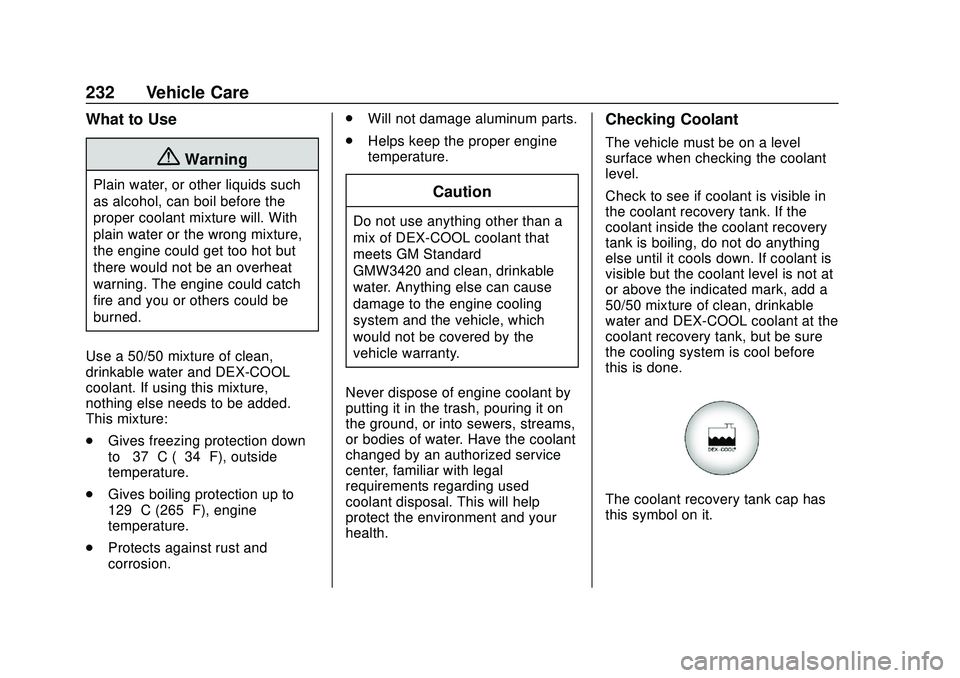
Chevrolet Express Owner Manual (GMNA-Localizing-U.S./Canada/Mexico-
13882570) - 2020 - CRC - 11/1/19
232 Vehicle Care
What to Use
{Warning
Plain water, or other liquids such
as alcohol, can boil before the
proper coolant mixture will. With
plain water or the wrong mixture,
the engine could get too hot but
there would not be an overheat
warning. The engine could catch
fire and you or others could be
burned.
Use a 50/50 mixture of clean,
drinkable water and DEX-COOL
coolant. If using this mixture,
nothing else needs to be added.
This mixture:
. Gives freezing protection down
to−37 °C (−34 °F), outside
temperature.
. Gives boiling protection up to
129 °C (265 °F), engine
temperature.
. Protects against rust and
corrosion. .
Will not damage aluminum parts.
. Helps keep the proper engine
temperature.Caution
Do not use anything other than a
mix of DEX-COOL coolant that
meets GM Standard
GMW3420 and clean, drinkable
water. Anything else can cause
damage to the engine cooling
system and the vehicle, which
would not be covered by the
vehicle warranty.
Never dispose of engine coolant by
putting it in the trash, pouring it on
the ground, or into sewers, streams,
or bodies of water. Have the coolant
changed by an authorized service
center, familiar with legal
requirements regarding used
coolant disposal. This will help
protect the environment and your
health.
Checking Coolant
The vehicle must be on a level
surface when checking the coolant
level.
Check to see if coolant is visible in
the coolant recovery tank. If the
coolant inside the coolant recovery
tank is boiling, do not do anything
else until it cools down. If coolant is
visible but the coolant level is not at
or above the indicated mark, add a
50/50 mixture of clean, drinkable
water and DEX-COOL coolant at the
coolant recovery tank, but be sure
the cooling system is cool before
this is done.
The coolant recovery tank cap has
this symbol on it.
Page 234 of 356
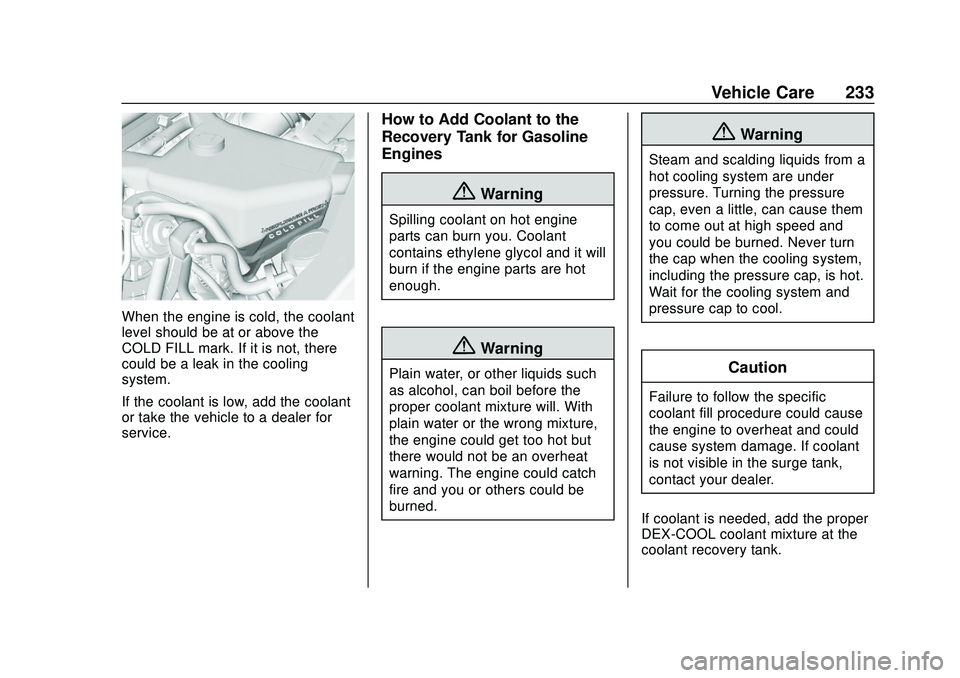
Chevrolet Express Owner Manual (GMNA-Localizing-U.S./Canada/Mexico-
13882570) - 2020 - CRC - 11/1/19
Vehicle Care 233
When the engine is cold, the coolant
level should be at or above the
COLD FILL mark. If it is not, there
could be a leak in the cooling
system.
If the coolant is low, add the coolant
or take the vehicle to a dealer for
service.
How to Add Coolant to the
Recovery Tank for Gasoline
Engines
{Warning
Spilling coolant on hot engine
parts can burn you. Coolant
contains ethylene glycol and it will
burn if the engine parts are hot
enough.
{Warning
Plain water, or other liquids such
as alcohol, can boil before the
proper coolant mixture will. With
plain water or the wrong mixture,
the engine could get too hot but
there would not be an overheat
warning. The engine could catch
fire and you or others could be
burned.
{Warning
Steam and scalding liquids from a
hot cooling system are under
pressure. Turning the pressure
cap, even a little, can cause them
to come out at high speed and
you could be burned. Never turn
the cap when the cooling system,
including the pressure cap, is hot.
Wait for the cooling system and
pressure cap to cool.
Caution
Failure to follow the specific
coolant fill procedure could cause
the engine to overheat and could
cause system damage. If coolant
is not visible in the surge tank,
contact your dealer.
If coolant is needed, add the proper
DEX-COOL coolant mixture at the
coolant recovery tank.
Page 236 of 356
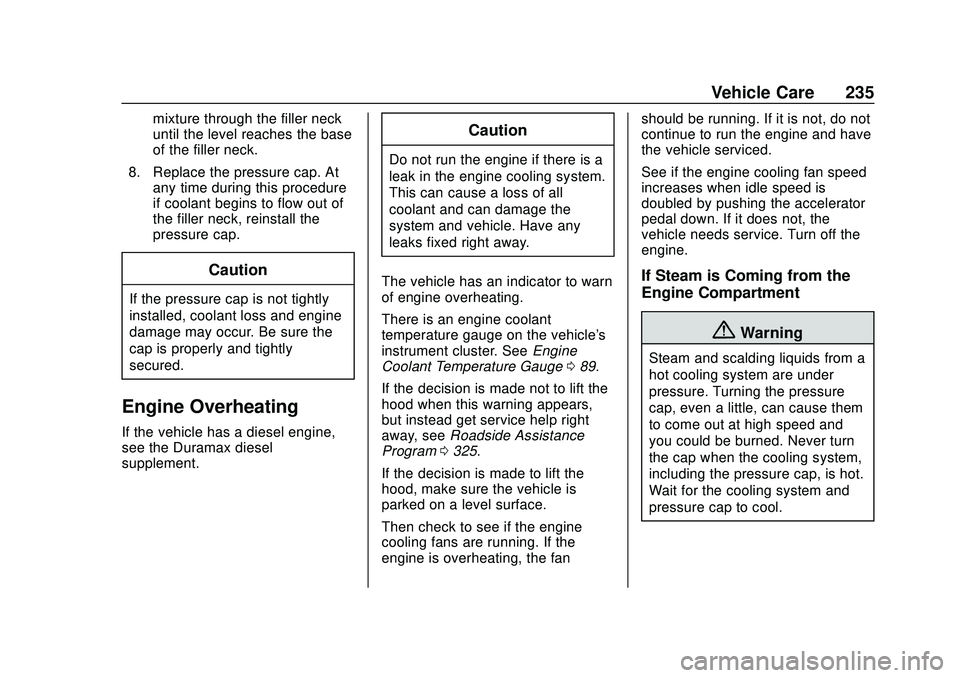
Chevrolet Express Owner Manual (GMNA-Localizing-U.S./Canada/Mexico-
13882570) - 2020 - CRC - 11/1/19
Vehicle Care 235
mixture through the filler neck
until the level reaches the base
of the filler neck.
8. Replace the pressure cap. At any time during this procedure
if coolant begins to flow out of
the filler neck, reinstall the
pressure cap.
Caution
If the pressure cap is not tightly
installed, coolant loss and engine
damage may occur. Be sure the
cap is properly and tightly
secured.
Engine Overheating
If the vehicle has a diesel engine,
see the Duramax diesel
supplement.
Caution
Do not run the engine if there is a
leak in the engine cooling system.
This can cause a loss of all
coolant and can damage the
system and vehicle. Have any
leaks fixed right away.
The vehicle has an indicator to warn
of engine overheating.
There is an engine coolant
temperature gauge on the vehicle's
instrument cluster. See Engine
Coolant Temperature Gauge 089.
If the decision is made not to lift the
hood when this warning appears,
but instead get service help right
away, see Roadside Assistance
Program 0325.
If the decision is made to lift the
hood, make sure the vehicle is
parked on a level surface.
Then check to see if the engine
cooling fans are running. If the
engine is overheating, the fan should be running. If it is not, do not
continue to run the engine and have
the vehicle serviced.
See if the engine cooling fan speed
increases when idle speed is
doubled by pushing the accelerator
pedal down. If it does not, the
vehicle needs service. Turn off the
engine.
If Steam is Coming from the
Engine Compartment
{Warning
Steam and scalding liquids from a
hot cooling system are under
pressure. Turning the pressure
cap, even a little, can cause them
to come out at high speed and
you could be burned. Never turn
the cap when the cooling system,
including the pressure cap, is hot.
Wait for the cooling system and
pressure cap to cool.
Page 237 of 356
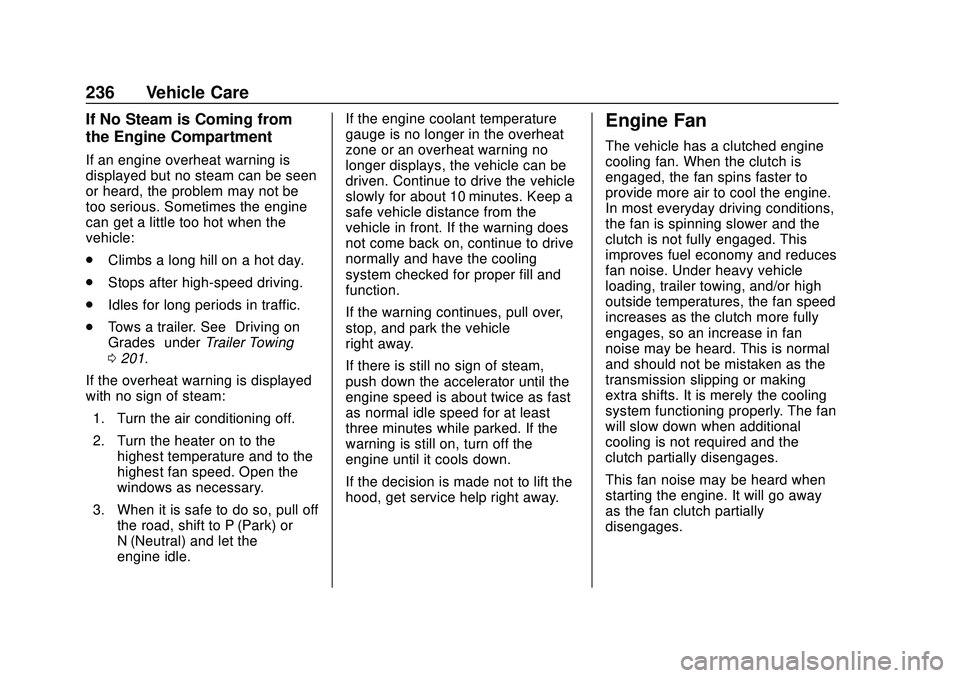
Chevrolet Express Owner Manual (GMNA-Localizing-U.S./Canada/Mexico-
13882570) - 2020 - CRC - 11/1/19
236 Vehicle Care
If No Steam is Coming from
the Engine Compartment
If an engine overheat warning is
displayed but no steam can be seen
or heard, the problem may not be
too serious. Sometimes the engine
can get a little too hot when the
vehicle:
.Climbs a long hill on a hot day.
. Stops after high-speed driving.
. Idles for long periods in traffic.
. Tows a trailer. See “Driving on
Grades” underTrailer Towing
0 201.
If the overheat warning is displayed
with no sign of steam: 1. Turn the air conditioning off.
2. Turn the heater on to the highest temperature and to the
highest fan speed. Open the
windows as necessary.
3. When it is safe to do so, pull off the road, shift to P (Park) or
N (Neutral) and let the
engine idle. If the engine coolant temperature
gauge is no longer in the overheat
zone or an overheat warning no
longer displays, the vehicle can be
driven. Continue to drive the vehicle
slowly for about 10 minutes. Keep a
safe vehicle distance from the
vehicle in front. If the warning does
not come back on, continue to drive
normally and have the cooling
system checked for proper fill and
function.
If the warning continues, pull over,
stop, and park the vehicle
right away.
If there is still no sign of steam,
push down the accelerator until the
engine speed is about twice as fast
as normal idle speed for at least
three minutes while parked. If the
warning is still on, turn off the
engine until it cools down.
If the decision is made not to lift the
hood, get service help right away.
Engine Fan
The vehicle has a clutched engine
cooling fan. When the clutch is
engaged, the fan spins faster to
provide more air to cool the engine.
In most everyday driving conditions,
the fan is spinning slower and the
clutch is not fully engaged. This
improves fuel economy and reduces
fan noise. Under heavy vehicle
loading, trailer towing, and/or high
outside temperatures, the fan speed
increases as the clutch more fully
engages, so an increase in fan
noise may be heard. This is normal
and should not be mistaken as the
transmission slipping or making
extra shifts. It is merely the cooling
system functioning properly. The fan
will slow down when additional
cooling is not required and the
clutch partially disengages.
This fan noise may be heard when
starting the engine. It will go away
as the fan clutch partially
disengages.
Page 348 of 356
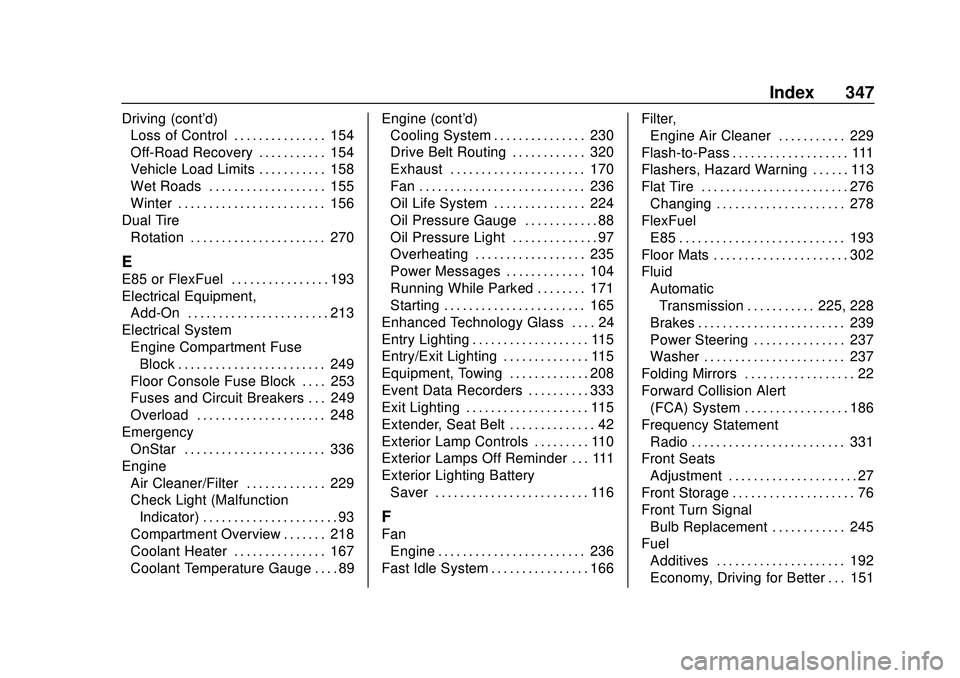
Chevrolet Express Owner Manual (GMNA-Localizing-U.S./Canada/Mexico-
13882570) - 2020 - CRC - 11/1/19
Index 347
Driving (cont'd)Loss of Control . . . . . . . . . . . . . . . 154
Off-Road Recovery . . . . . . . . . . . 154
Vehicle Load Limits . . . . . . . . . . . 158
Wet Roads . . . . . . . . . . . . . . . . . . . 155
Winter . . . . . . . . . . . . . . . . . . . . . . . . 156
Dual Tire
Rotation . . . . . . . . . . . . . . . . . . . . . . 270
E
E85 or FlexFuel . . . . . . . . . . . . . . . . 193
Electrical Equipment,Add-On . . . . . . . . . . . . . . . . . . . . . . . 213
Electrical System Engine Compartment FuseBlock . . . . . . . . . . . . . . . . . . . . . . . . 249
Floor Console Fuse Block . . . . 253
Fuses and Circuit Breakers . . . 249
Overload . . . . . . . . . . . . . . . . . . . . . 248
Emergency OnStar . . . . . . . . . . . . . . . . . . . . . . . 336
Engine
Air Cleaner/Filter . . . . . . . . . . . . . 229
Check Light (MalfunctionIndicator) . . . . . . . . . . . . . . . . . . . . . . 93
Compartment Overview . . . . . . . 218
Coolant Heater . . . . . . . . . . . . . . . 167
Coolant Temperature Gauge . . . . 89 Engine (cont'd)
Cooling System . . . . . . . . . . . . . . . 230
Drive Belt Routing . . . . . . . . . . . . 320
Exhaust . . . . . . . . . . . . . . . . . . . . . . 170
Fan . . . . . . . . . . . . . . . . . . . . . . . . . . . 236
Oil Life System . . . . . . . . . . . . . . . 224
Oil Pressure Gauge . . . . . . . . . . . . 88
Oil Pressure Light . . . . . . . . . . . . . . 97
Overheating . . . . . . . . . . . . . . . . . . 235
Power Messages . . . . . . . . . . . . . 104
Running While Parked . . . . . . . . 171
Starting . . . . . . . . . . . . . . . . . . . . . . . 165
Enhanced Technology Glass . . . . 24
Entry Lighting . . . . . . . . . . . . . . . . . . . 115
Entry/Exit Lighting . . . . . . . . . . . . . . 115
Equipment, Towing . . . . . . . . . . . . . 208
Event Data Recorders . . . . . . . . . . 333
Exit Lighting . . . . . . . . . . . . . . . . . . . . 115
Extender, Seat Belt . . . . . . . . . . . . . . 42
Exterior Lamp Controls . . . . . . . . . 110
Exterior Lamps Off Reminder . . . 111
Exterior Lighting Battery Saver . . . . . . . . . . . . . . . . . . . . . . . . . 116
F
FanEngine . . . . . . . . . . . . . . . . . . . . . . . . 236
Fast Idle System . . . . . . . . . . . . . . . . 166 Filter,
Engine Air Cleaner . . . . . . . . . . . 229
Flash-to-Pass . . . . . . . . . . . . . . . . . . . 111
Flashers, Hazard Warning . . . . . . 113
Flat Tire . . . . . . . . . . . . . . . . . . . . . . . . 276 Changing . . . . . . . . . . . . . . . . . . . . . 278
FlexFuel
E85 . . . . . . . . . . . . . . . . . . . . . . . . . . . 193
Floor Mats . . . . . . . . . . . . . . . . . . . . . . 302
Fluid Automatic
Transmission . . . . . . . . . . . 225, 228
Brakes . . . . . . . . . . . . . . . . . . . . . . . . 239
Power Steering . . . . . . . . . . . . . . . 237
Washer . . . . . . . . . . . . . . . . . . . . . . . 237
Folding Mirrors . . . . . . . . . . . . . . . . . . 22
Forward Collision Alert
(FCA) System . . . . . . . . . . . . . . . . . 186
Frequency Statement Radio . . . . . . . . . . . . . . . . . . . . . . . . . 331
Front Seats
Adjustment . . . . . . . . . . . . . . . . . . . . . 27
Front Storage . . . . . . . . . . . . . . . . . . . . 76
Front Turn Signal Bulb Replacement . . . . . . . . . . . . 245
Fuel Additives . . . . . . . . . . . . . . . . . . . . . 192
Economy, Driving for Better . . . 151
Page 351 of 356
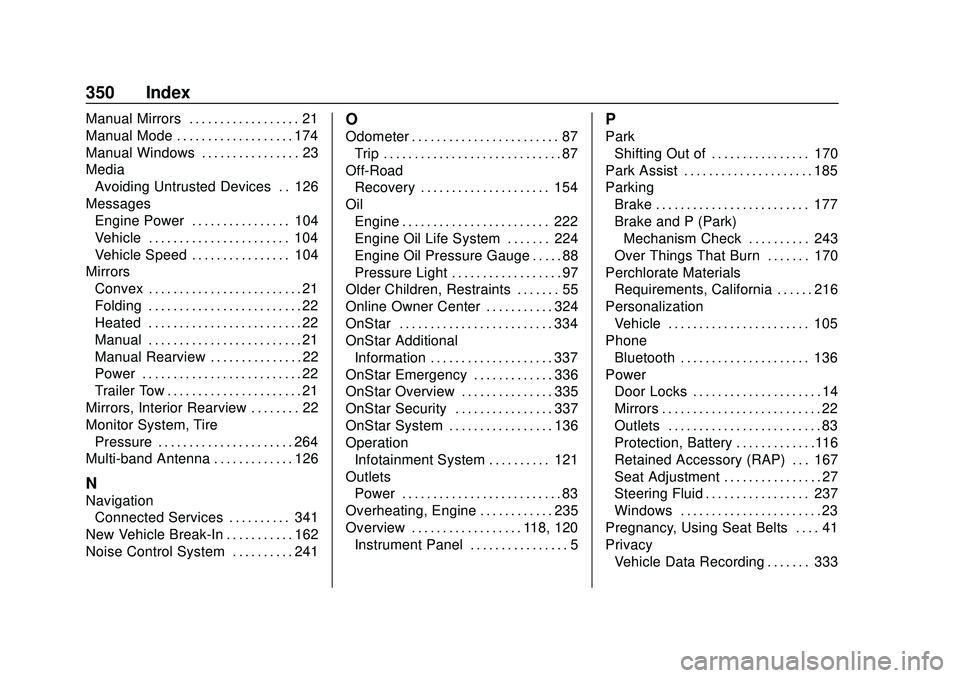
Chevrolet Express Owner Manual (GMNA-Localizing-U.S./Canada/Mexico-
13882570) - 2020 - CRC - 11/1/19
350 Index
Manual Mirrors . . . . . . . . . . . . . . . . . . 21
Manual Mode . . . . . . . . . . . . . . . . . . . 174
Manual Windows . . . . . . . . . . . . . . . . 23
MediaAvoiding Untrusted Devices . . 126
Messages Engine Power . . . . . . . . . . . . . . . . 104
Vehicle . . . . . . . . . . . . . . . . . . . . . . . 104
Vehicle Speed . . . . . . . . . . . . . . . . 104
Mirrors Convex . . . . . . . . . . . . . . . . . . . . . . . . . 21
Folding . . . . . . . . . . . . . . . . . . . . . . . . . 22
Heated . . . . . . . . . . . . . . . . . . . . . . . . . 22
Manual . . . . . . . . . . . . . . . . . . . . . . . . . 21
Manual Rearview . . . . . . . . . . . . . . . 22
Power . . . . . . . . . . . . . . . . . . . . . . . . . . 22
Trailer Tow . . . . . . . . . . . . . . . . . . . . . . 21
Mirrors, Interior Rearview . . . . . . . . 22
Monitor System, Tire Pressure . . . . . . . . . . . . . . . . . . . . . . 264
Multi-band Antenna . . . . . . . . . . . . . 126
N
Navigation
Connected Services . . . . . . . . . . 341
New Vehicle Break-In . . . . . . . . . . . 162
Noise Control System . . . . . . . . . . 241
O
Odometer . . . . . . . . . . . . . . . . . . . . . . . . 87
Trip . . . . . . . . . . . . . . . . . . . . . . . . . . . . . 87
Off-Road Recovery . . . . . . . . . . . . . . . . . . . . . 154
Oil Engine . . . . . . . . . . . . . . . . . . . . . . . . 222
Engine Oil Life System . . . . . . . 224
Engine Oil Pressure Gauge . . . . . 88
Pressure Light . . . . . . . . . . . . . . . . . . 97
Older Children, Restraints . . . . . . . 55
Online Owner Center . . . . . . . . . . . 324
OnStar . . . . . . . . . . . . . . . . . . . . . . . . . 334
OnStar Additional Information . . . . . . . . . . . . . . . . . . . . 337
OnStar Emergency . . . . . . . . . . . . . 336
OnStar Overview . . . . . . . . . . . . . . . 335
OnStar Security . . . . . . . . . . . . . . . . 337
OnStar System . . . . . . . . . . . . . . . . . 136
Operation Infotainment System . . . . . . . . . . 121
Outlets Power . . . . . . . . . . . . . . . . . . . . . . . . . . 83
Overheating, Engine . . . . . . . . . . . . 235
Overview . . . . . . . . . . . . . . . . . . 118, 120
Instrument Panel . . . . . . . . . . . . . . . . 5
P
ParkShifting Out of . . . . . . . . . . . . . . . . 170
Park Assist . . . . . . . . . . . . . . . . . . . . . 185
Parking Brake . . . . . . . . . . . . . . . . . . . . . . . . . 177
Brake and P (Park)Mechanism Check . . . . . . . . . . 243
Over Things That Burn . . . . . . . 170
Perchlorate Materials
Requirements, California . . . . . . 216
Personalization Vehicle . . . . . . . . . . . . . . . . . . . . . . . 105
Phone
Bluetooth . . . . . . . . . . . . . . . . . . . . . 136
Power Door Locks . . . . . . . . . . . . . . . . . . . . . 14
Mirrors . . . . . . . . . . . . . . . . . . . . . . . . . . 22
Outlets . . . . . . . . . . . . . . . . . . . . . . . . . 83
Protection, Battery . . . . . . . . . . . . .116
Retained Accessory (RAP) . . . 167
Seat Adjustment . . . . . . . . . . . . . . . . 27
Steering Fluid . . . . . . . . . . . . . . . . . 237
Windows . . . . . . . . . . . . . . . . . . . . . . . 23
Pregnancy, Using Seat Belts . . . . 41
Privacy Vehicle Data Recording . . . . . . . 333